And now for something a little different
Working on understanding the other side
Ever feel uncomfortably at odds with the people you think you should be agreeing with? Surely we’ve all felt this way at some point, and perhaps many of us are feeling this acutely in the post-election period. I feel it when I'm wasting time online in spaces where gardening is discussed, and I sense a gulf between the ascendant ecologically-minded gardening doctrines of the No Mow May, leaf-leaving, clean-up eschewing, lawn-killing, native plant purists, and my way of doing things. This post isn't a diatribe against this folks, whom I’ve come to consider well-meaning and sincerely interested in caring for the environment and our non-human neighbors. However, I often find them militant and dogmatic, and I wanted to take a look at reasons they do the things they do. The place to start is to examine material conditions.
I think No Mow May is silly. I rake my leaves and have planted many species that originated on other continents. I enjoy my lawn and spend pleasant autumn afternoons tidying up the vegetable garden. Many in the aforementioned crowd would look askance at my habits, but I’m not a bad person or a bad land steward. I’m merely in a different environment from most of these folks.
It is tempting to think that their dogmatic beliefs about best practices have arisen due to spending too much time in social media echo chambers, and are untethered from physical conditions, and that my beliefs are a natural result of observing and reacting to my environment. There is way too much of this type of thinking right now — believing I am rational and well-informed and you are brainwashed by disinformation. We need to get away from that mindset, and I’ve made a conscious effort to understand why these folks think and act they way they do.
To understand why the urban/suburban arm of the ecological gardening movement is so militantly anti-lawn, anti-exotic plant, anti-rake, and anti-clean up in general, I needed to look at their surroundings. According census data, 80% of the U.S. population lives in urban areas. This may seem remarkably high, but it makes more sense once you know that the census doesn't distinguish between urban and suburban, but groups together all areas above a certain population density. The remainder of the population is considered rural.
Luckily for me and citizen researchers everywhere, it behooves realtors to have access to data concerning lot size. A quick internet search reveals that average lot size in the U.S. fell from just under an acre in 1978, to about a third of an acre in 2020. (from Angi, the home services clearinghouse, using data from Zillow.) Because these numbers indicate average size, we may assume many homes are situated on even smaller lots.
It follows from this information that most gardeners in the U.S. are practicing their craft in cities and suburbia, in yards ranging from small to minuscule, surrounded by sprawling expanses of other small yards and quite a bit of pavement. Although rural people like me sit on larger acreages, and have control over much more land individually, there are many more urban and suburban dwellers who own much land in aggregate. Among these folk are those who are interested not only in sustainable practices, but in actively restoring their land and ecosystems to the greatest extent possible under the conditions. They follow advice from others who are dealing with similar conditions because it makes sense.
Although there are exceptions, suburbia and residential urban areas are to a great degree ecological wastelands where land not covered by buildings and pavement consists of mulch-covered landscape fabric and turfgrass. Native plants are rare and those present are often modified to the point of being unrecognizable. Native tree and shrub seeds seldom drift in the wind because there is no source for them, nor do they often fall from bird butts. The birds that brave this uninviting landscape are most likely consuming— and pooping out — the berries of exotics. In prosperous neighborhoods, if a stray leaf or volunteer plant graces the landscaping it is quickly removed by a trained professional. The yards provide little use to any species besides humans, and and are arguably merely outdoor extensions of indoor spaces.
Residents who become interested in native plants, creating wildlife habitat, sequestering carbon, or just becoming better land stewards in general, may find themselves battling uphill. They are often severely restricted by city ordinances and HOA rules. They are limited by space constraints. They cannot simply allow rewilding to happen because it won’t work: There is a lack of native plants to supply a seed source and little in the way of seeds from native plants stored in the soil seed bank.
That we have created vast expanses where natural regeneration simply doesn't occur is disturbing, but it does help to explain certain attitudes. When a suburban denizen for whatever reason decides to buck the trend and opt for a more eco-friendly yard, the results will likely differ wildly from what I'm witnessing here on the farm. Like the human gut after taking a course of antibiotics, the sterile environment of the typical suburban yard — if suddenly let go — will erupt in growth of unwanted organisms. Plants and bugs suddenly unsuppressed by chemicals and with no competition whatsoever will have a field day colonizing available niches.
The sudden growth of vegetation will mostly consist of plants that are grown and valued by neighbors, or tough pioneer plants waiting for an opportunity to spread. Barberry, winter creeper, burning bush, privet, English ivy, and Chinese maiden grass are popular landscaping plants that readily propagate themselves, while Japanese honeysuckle, multiflora rose, and autumn olive live in waste areas and spread seeds far and wide. None of these is indigenous, and the native plant enthusiast will quickly realize that for their purposes there is no appreciable difference between coveted landscape specimens and common weeds.
Under these conditions, it makes sense that a gardener seeking more ecologically sound practices must adopt a combative attitude, and approach tasks as battles. Invasives must be attacked and driven from the borders. Lawns must be assaulted. Creating a wildlife friendly yard, rich with ecosystem services, is much like establishing a combat outpost surrounded by hostile forces: HOAs, opinionated neighbors, invasive plants, and even construction debris buried by builders stymie efforts.
The lack of natural predators to keep pests under control is a huge problem. Because there are few native trees, shrubs, and wildflowers to support a healthy food web of birds, predatory insects, and spiders, certain bugs proliferate and can be highly destructive. Both foreign invaders like Japanese beetles and natives such as bagworms are scary when they seem poised to eat everything. Vegetable gardening is especially difficult when the aphids, bean beetles, squash bugs, and cabbage loopers arrive and decimate plantings. Desperate gardeners come to believe it’s impossible to grow anything without chemicals, and seek out those of lesser evil like neem oil, or resort to hours spend hand-picking.
While invasive plants and destructive insects are battled, any native plants that appear are welcomed. Species that I remove constantly such as violets, wild asters, and golderod are treated like rare and precious jewels. Fallen leaves are considered sacred, as are the spaces inside stalks which harbor insect larvae. “Cleaning up” is frowned upon, since it removes food for overwintering birds and destroys arthropods living in debris. Under the care of a committed steward, a small yard can be an oasis of functioning nature in a desert of sterility and it is no wonder homeowners feel that rules must be closely followed to ensure benefits are maximized.
The situation on the farm is different. If I lack the motivation to assault my lawn, it’s not because I disagree that lawns can be a blight on the landscape. They are in many settings not only purposeless but toxic. However, it’s possible to have a non-toxic and useful lawn, especially out in the country. We neither irrigate nor fertilize, but regularly mow in order to keep nature at bay. If we abandoned the task, trees and brush would quickly encroach upon the house, menacing the foundation and the roof because, in contrast to much of suburbia, we are overrun with native tree and shrub volunteers.
Cherries, locust, mulberries regularly pop up in the vegetable garden, as do oak and sassafras in the orchard. Maple seedlings appear in the lawn if we miss a spot. Blackberry brambles show up literally everywhere. If I stopped mowing, digging, hacking, weeding, and trimming for just a season, the result would be greatly reduced space and sunlight for plants that feed humans, loss of my beautiful herb and perennial beds, and lots more poison ivy.
Farther afield, pawpaws, sycamores, tulip poplars, and box elders throng the lower slopes of the Savanna, the name I’ve given to our abandoned cornfield. I certainly value native wildflowers, but we have acres of them and don’t need to protect each individual. Ironweed, Joe Pie weed, asters, wingstem, and woodland sunflowers vie with multiflora rose for space in sunny spots. Seedbox, beggarticks, and tearthumb fill the damp areas near the frog ponds. The upper Savanna is a sea of goldenrod.
In a nutshell, conditions here are the opposite of what is described above. Rather than a small spot of nature in a green desert, ours is an open space carved out of woods that threaten to overrun us at a hint of relaxed vigilance. The leaves I rake from the lawn, and the debris I remove from the potager are inconsequential next to the acres of woods and brush that surround us. There is plenty of room for plants native and not, and our wild areas support healthy populations of not only pollinating insects, but also birds, reptiles, amphibians, and mammals.
What is happening here is not due to an exceptional site, a great management plan, or moral superiority. It's just the way things are in much of the world, outside of highly developed areas. When there is plenty of rain, sunlight, space, and nearby sources of native seed, the result is regeneration if you simply step back and allow it to happen. The prodigious amounts of rain we receive in this valley and the extra fertility from the livestock are definitely factors, but the rampant growth would persist in their absence. I help things along by removing certain invasives when I have time, but native plants are triumphing, and would continue to do so without my help. If anything, I’ve become less inclined to remove invasive rose and honeysuckle because they protect young trees from bucks whose enthusiastic rubbing can be deadly.
Most gardeners and land stewards don’t have the luxury of such a laissez-faire approach. Considering the conditions of many gardeners, no wonder the call to obliterate all non-natives and replace exclusively with native plants. No wonder anything considered wasteful such as lawn or purely ornamental plants is proscribed. No wonder the insistence on hard and fast rules concerning leaving leaves and other debris, and never cleaning up. With local ordinances, HOA rules, and activist neighbors arrayed against them, a militant approach is required.
My goals don’t differ significantly from those of landowners struggling to reestablish bits of nature in areas devoid of functioning ecosystems. Zooming out, it’s clear that in its own way, the farm is an oasis also. Across the river are conventional farms raising gmo corn with plenty of glyphosate and petroleum based fertilizers. Upriver, unconventional horizontal wells extract natural gas from under national forest land (commonly known as fracking). Though not visible from my porch, there's plenty of industrial development here including pipeyards, warehouses, and plastic manufacturing facilities. Fortunately, there are also steep hillsides abandoned over a century ago, and plenty of undevelopable bottomland that form a critical mass of functioning ecosystems holding native seed donors to jumpstart regeneration. Let’s hope the small yards of feisty suburbanites struggling to be good land stewards cease to be isolated outposts, and act as our local wild areas do — as examples to be emulated, and cradles for flourishing communities of native flora and fauna.
Photos:
Sassafras at peak color
The final harvest
Invasive but beautiful callery pear
Everbearing blackberry
Insect water station
Right-of-way goldenrod
Borage in autumn


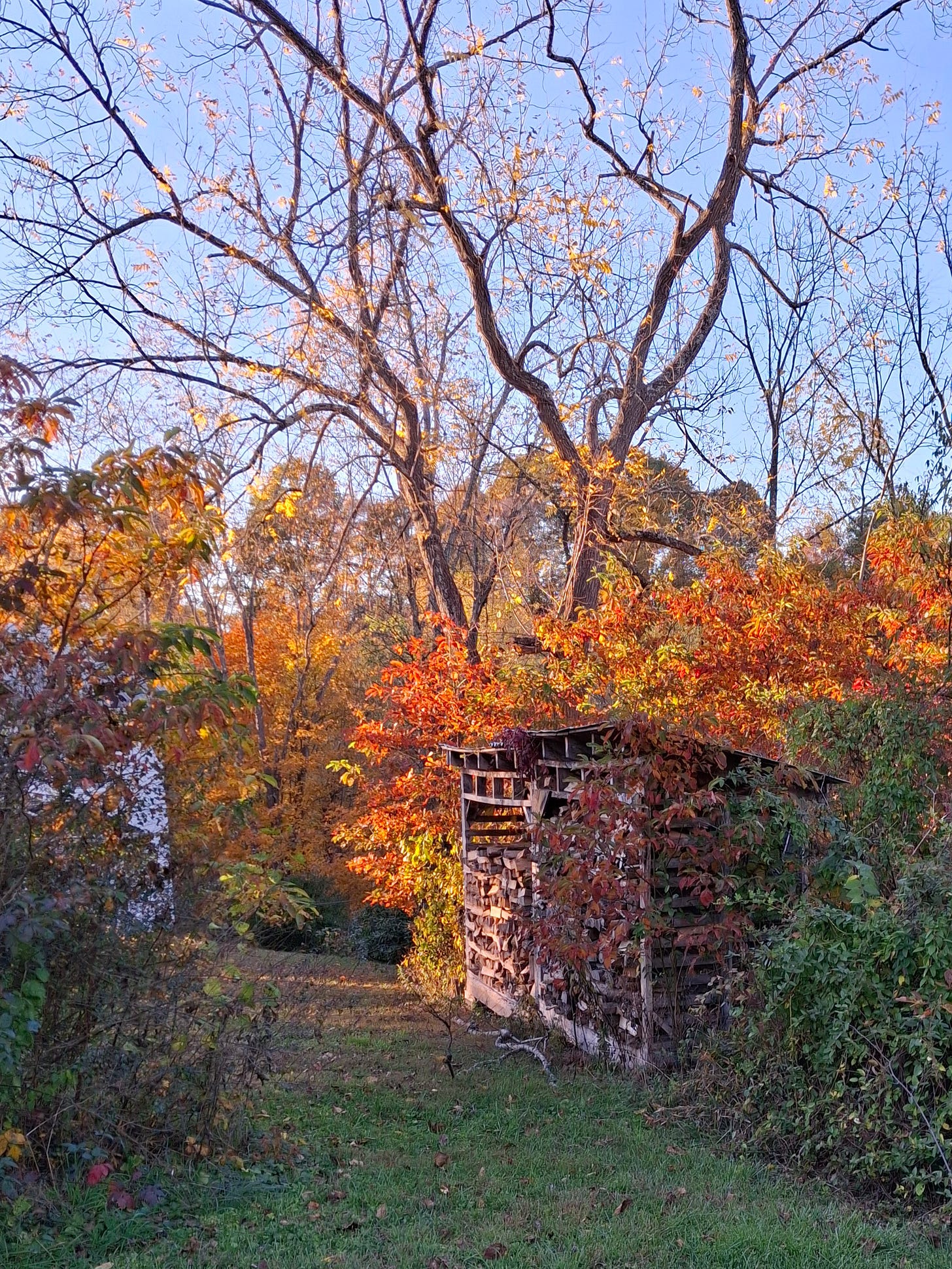
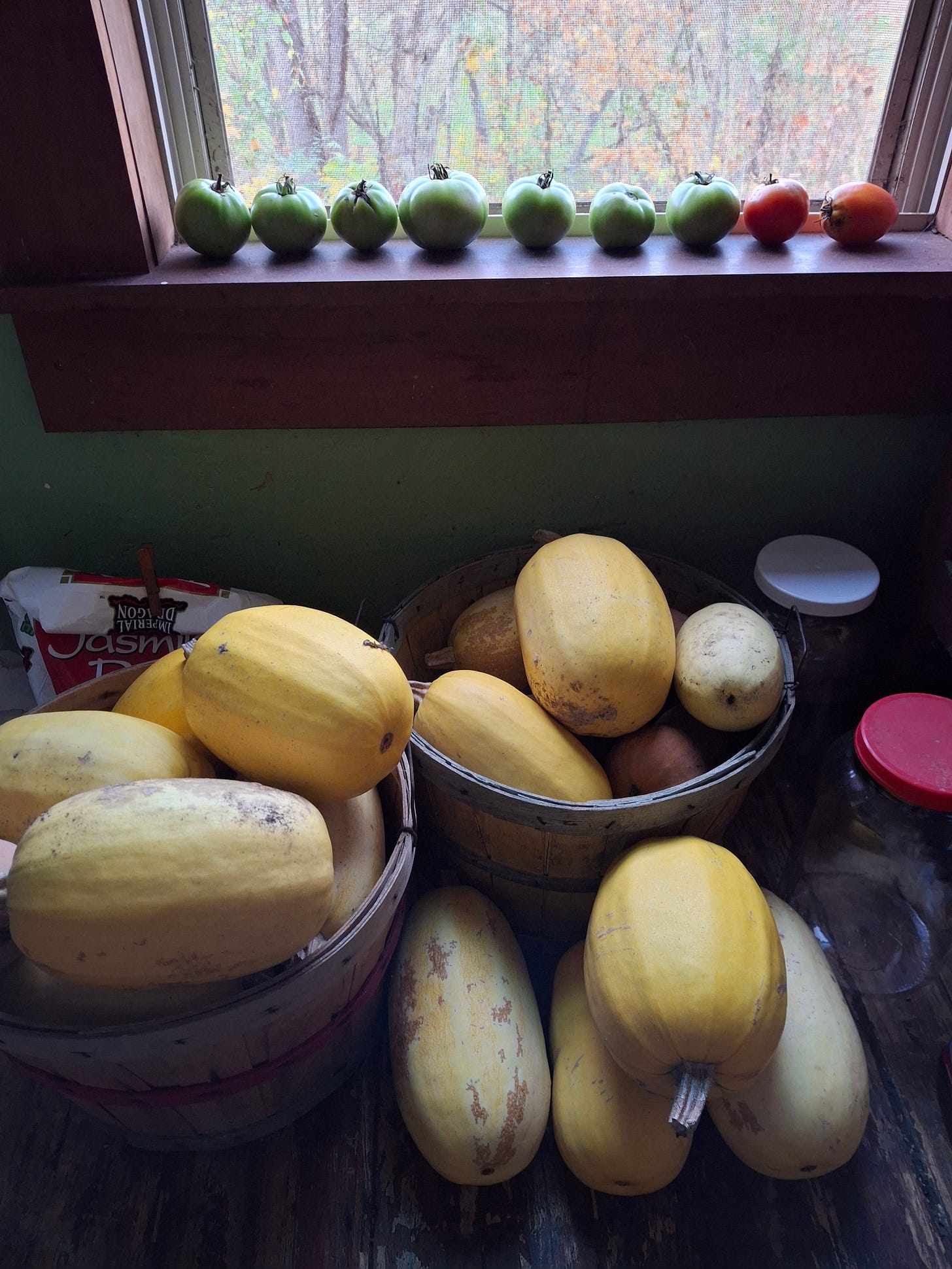
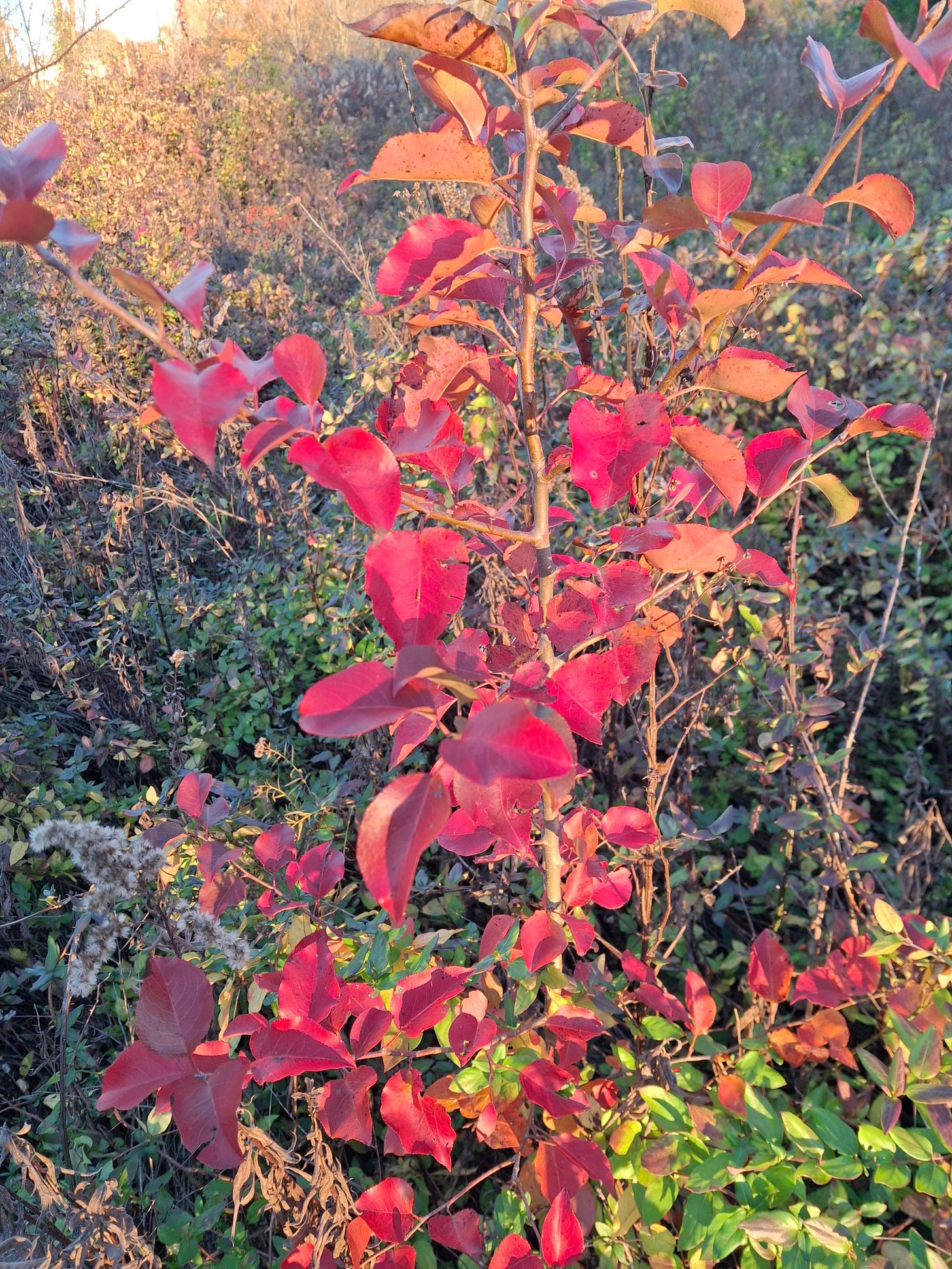
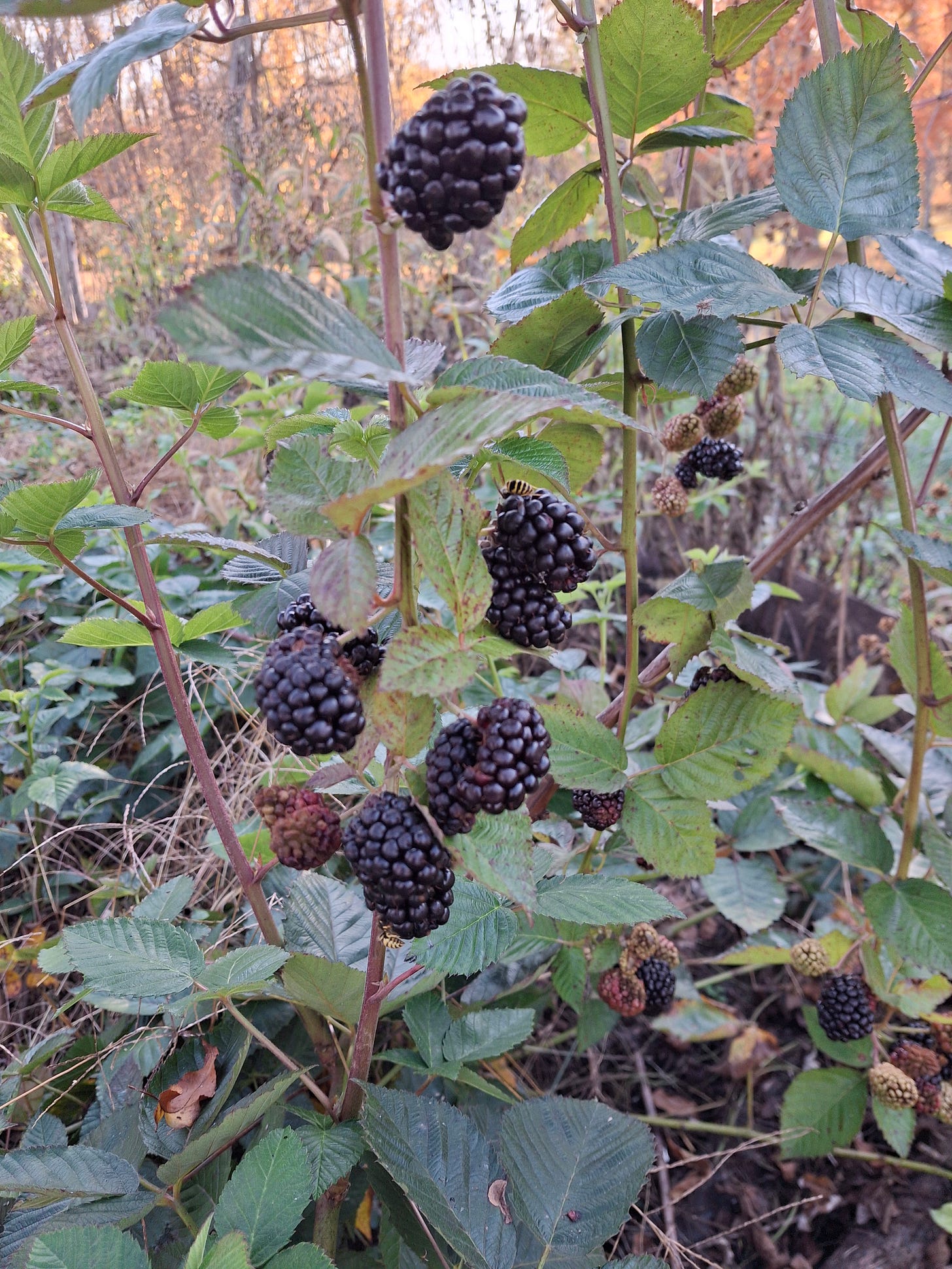
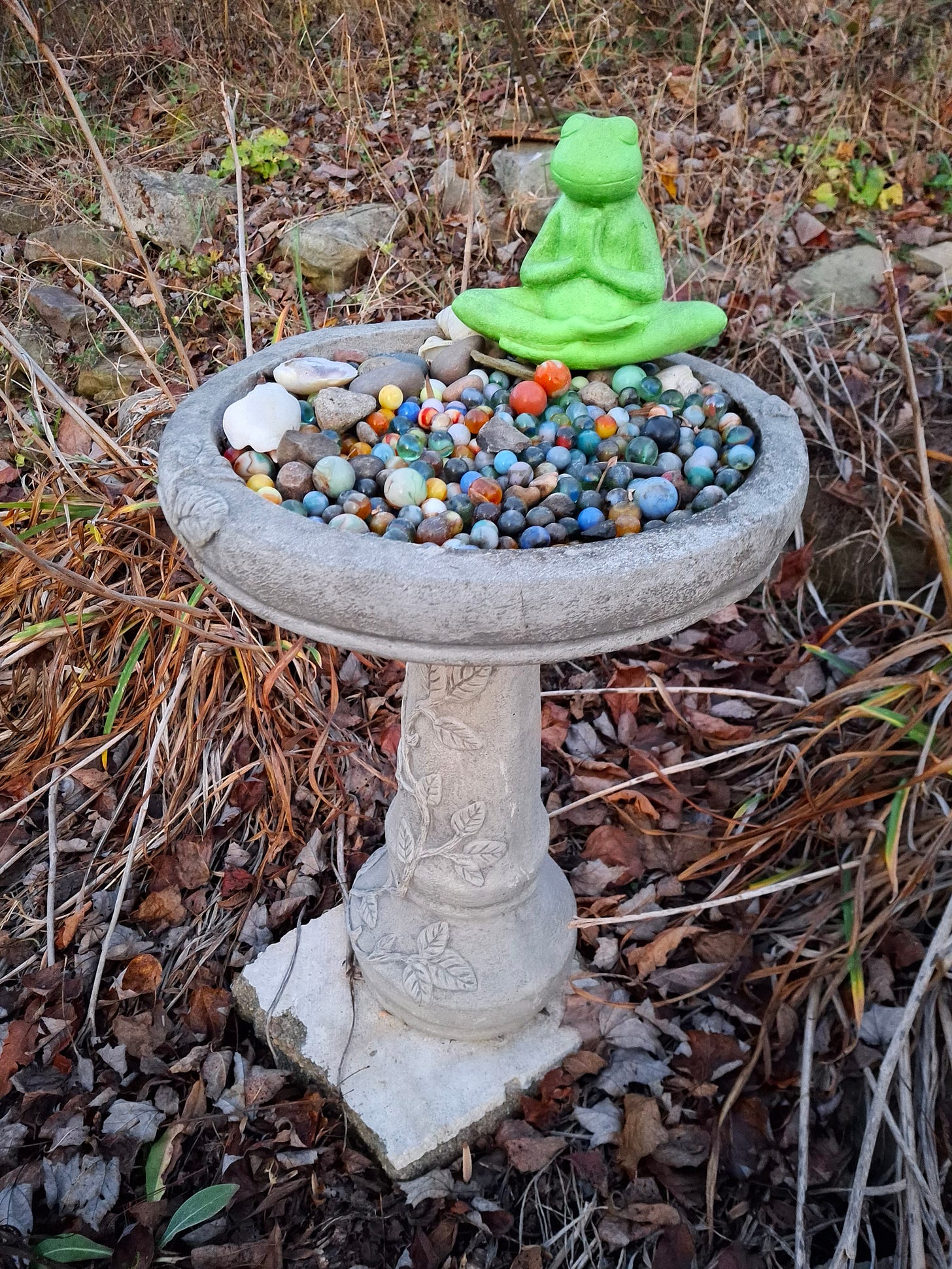
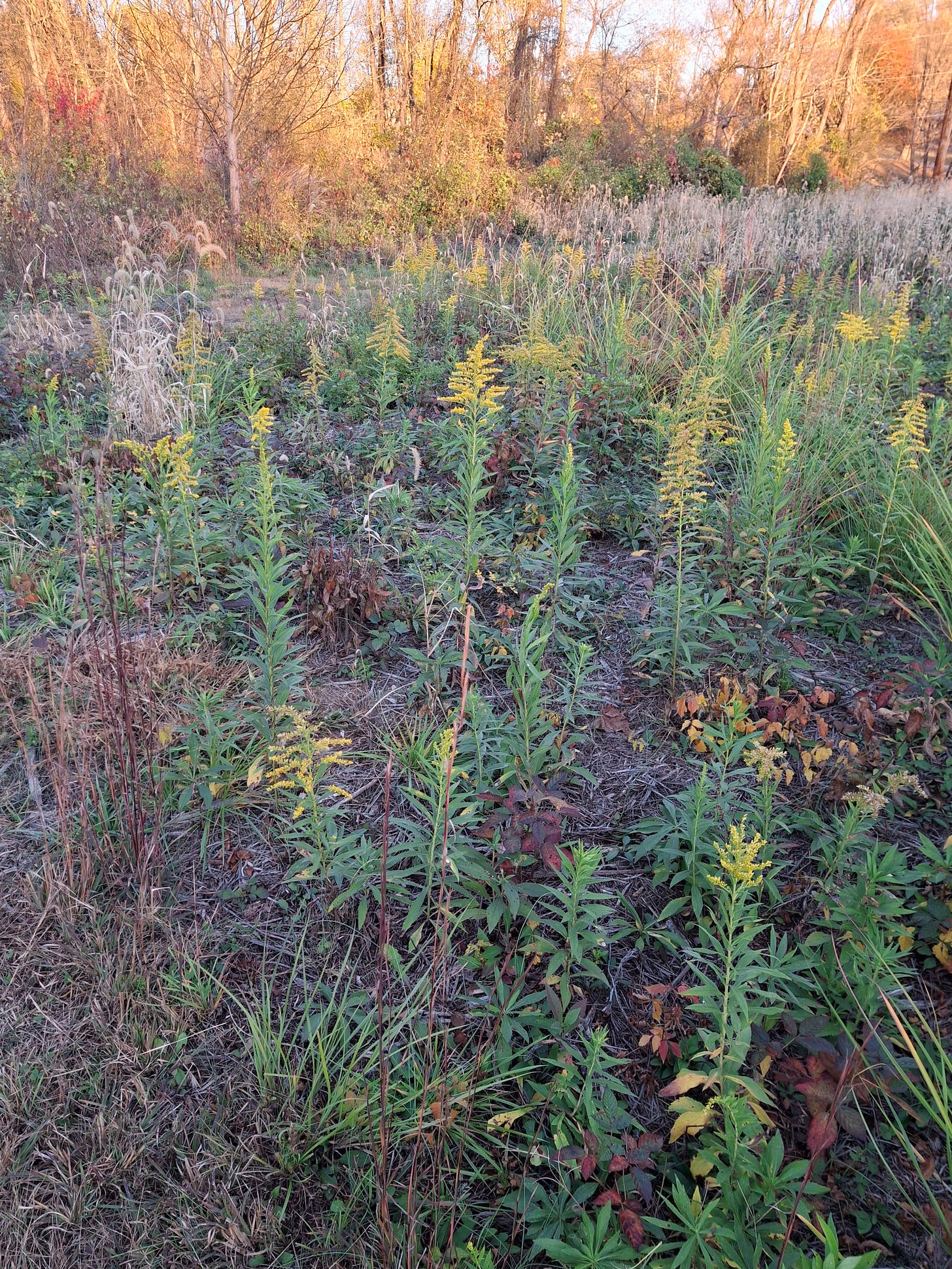
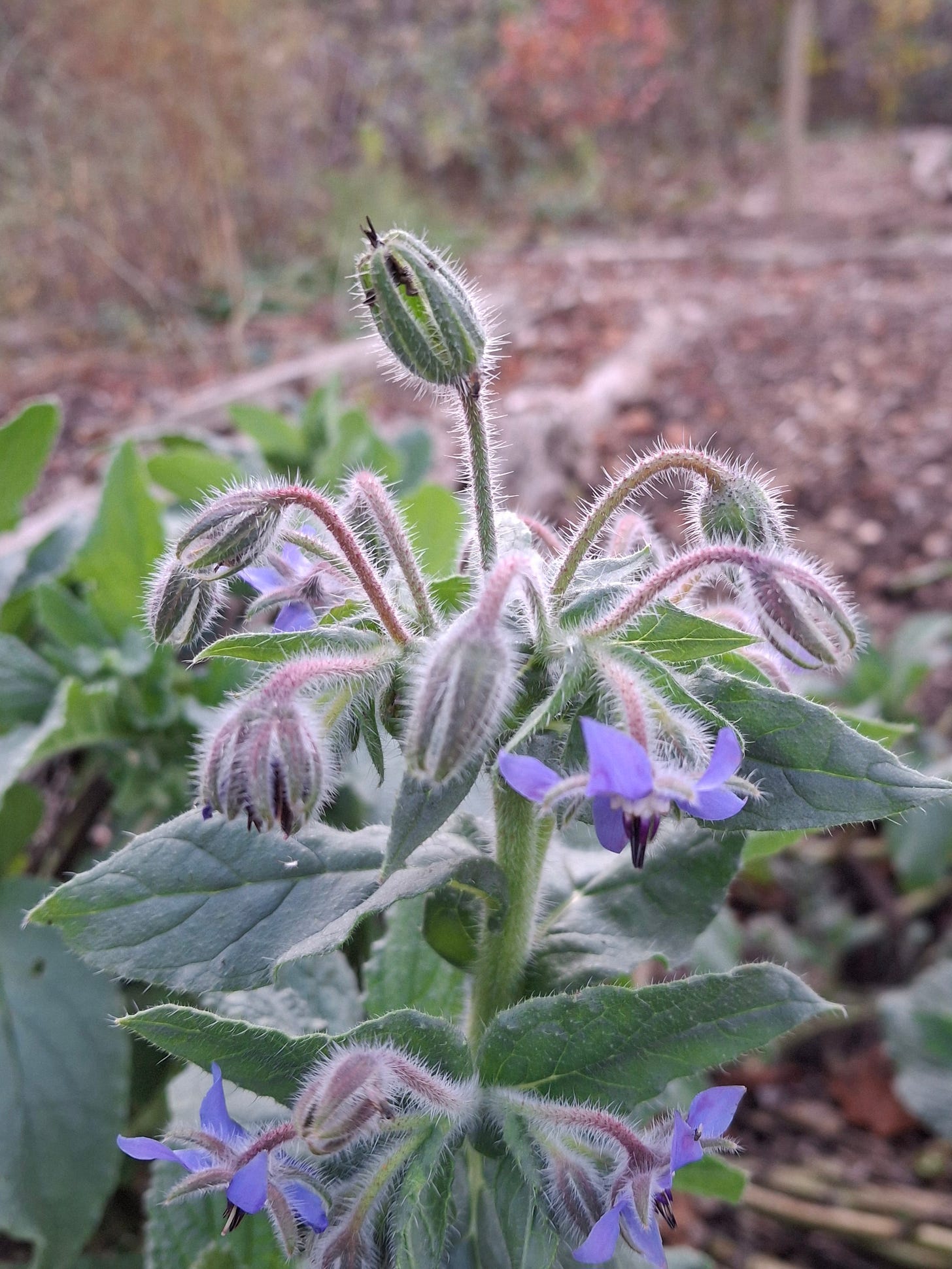
Fascinating Lynn, thanks for the insights. No grass lawn here but a new microclover lawn which I don't feed, treat or cut. But my garden is surrounded by our organic farm so I'm continually tackling the arrivals that I don't want. It's the same in the fields, I want more grassland diversity but hogweed has other ideas while our wonderful centuries old hedgerows need management to keep the brambles from dominating all. They are wonderful plants for bringing in insects and birds but are so invasive. But there is one advantage in that they protect the oak seedlings from deer and after a few years they appear above the brambles and start to shade them out.
As someone who gardens in a small suburban lot this article made me feel very seen. My tiny outpost of native habitat feels constantly under assault from the Bradford pear seedlings dropped by my neighbors tree, as well as English ivy creeping under the other neighbors fence. Militancy is needed. I have to bike 15 minutes to find the next closest milkweed plant. My yard has the only standing deadwood within 10 minutes, and as a consequence the small gathering of leafcutter bees that live in holes drilled into that standing deadwood are likely the only population of them in my immediate area. It feels really really difficult. One of my neighbors called the police on me because I looked suspicious "wielding a hoe". Suburbia!